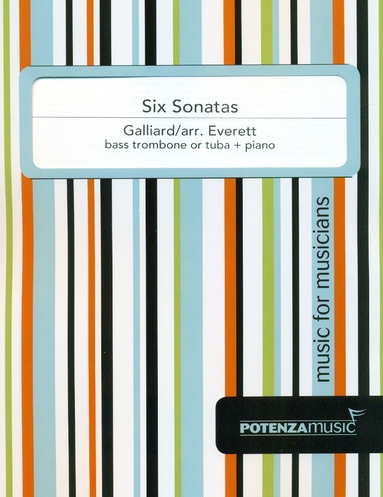Johann Ernst Galliard
 Six Sonatas:
Six Sonatas:
Arranged by Micah Everett
Louisville, KY, United States
Publisher: Potenza Music Publishing
Date of Publication: 2023
URL: http://www.potenzamusic.com
Primary Genre: Solo Bass/Contrabass Trombone - with piano
 Six Sonatas:
Six Sonatas: Arranged by Micah Everett
Louisville, KY, United States
Publisher: Potenza Music Publishing
Date of Publication: 2023
URL: http://www.potenzamusic.com
Primary Genre: Solo Bass/Contrabass Trombone - with piano
The Six Sonatas of Johann Ernst Galliard, first published in 1733 in London by John Walsh for bassoon or cello solo with harpsichord, are well-established solos for both tenor and bass trombonists. Along with the Six Sonatas by Benedetto Marcello (ca. 1732), they form part of the core repertoire of baroque-era transcriptions that help trombone players develop technique and style. The sonatas are available in numerous editions among which is the popular publication edited by Keith Brown (1963) for International Music Company with keyboard realization by Karl Heinz Fussel. While the sonatas in their original keys are quite suitable for bass trombone–they range from CC to g1–Micah Everett has given us a new edition that is transcribed down a fourth or fifth. He has created a new piano accompaniment from Galliard’s figured bass and he makes clear in his introductory notes that no attempt has been made to “present scholarly conventions regarding the interpretation of ‘early music.’” The business of preparing an edition of a baroque work is a daunting one. The first edition of the sonatas contains little guidance for the performers regarding dynamics and articulations. While many editions of the sonatas are, as a result, heavily edited, Everett is rather restrained in his markings. His is an edition that will result in what he aptly describes as a “pleasing performance.” That said, this new edition eschews many of Galliard’s original ornaments and printed dynamics while adding many more. Instead of using the composer’s marking for a trill, Everett employs a marking for a mordent without explaining how this kind of gesture might be interpreted. Certainly there is room for improvisatory ornamentation in this music, as evidenced by the recent recordings of the sonatas by Mike Hall, and Everett’s edition features editing that is tasteful and idiomatic for the modern player. The inclusion of the bass figures enhances Everett’s excellent and playable piano realization, a realization that is neither over-romanticized nor overly austere in a faux-baroque style. While Everett expresses the hope that the transposition to new keys would not go “so low that clarity and facility might be compromised,” in practice, some of the sonatas now have passages that would tax even accomplished players, such as places in Sonata III and Sonata V that go down to FF and GG at rapid tempi. The piano part is spiral bound and the solo part is stapled, and the printing is crisp and clear on bright white paper. Potenza Music’s layout of the solo part, however, is typical of much of today’s computer generated publishing, with too much white space on pages and a spread out look to the music that is distracting to the eye. The solo part to the finale to Sonata I is also missing the first and second ending indications that leads the soloist to play an extra measure on the repeat, and the placement of the da capo marking and coda at the end of the movement is confusing. These and a few other small notational mistakes in the piano part notwithstanding, Everett’s edition is both welcome and useful; it is a fine addition to the library of any aspiring bass trombone or tuba player. Recommended. -Douglas Yeo Arizona State University (retired) Boston Symphony Orchestra (retired)
Reviewer: Review Author
Review Published July 10, 2023
Review Published July 10, 2023